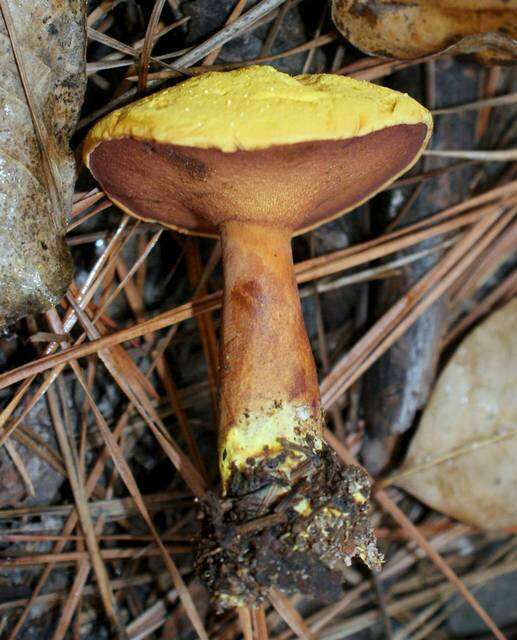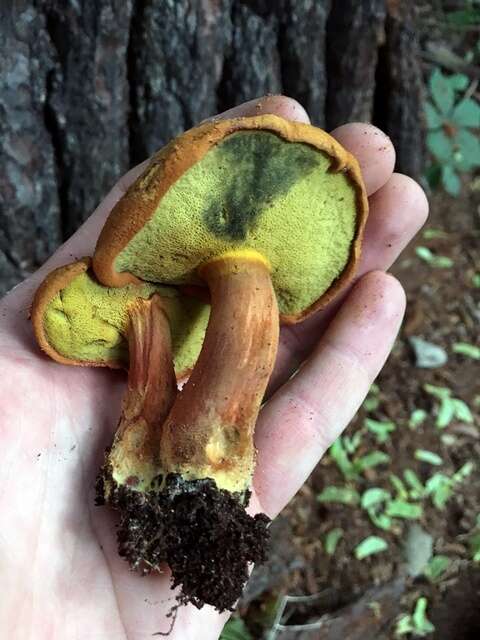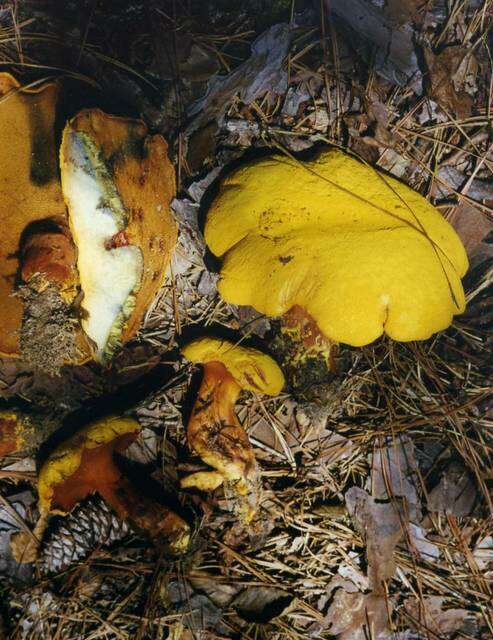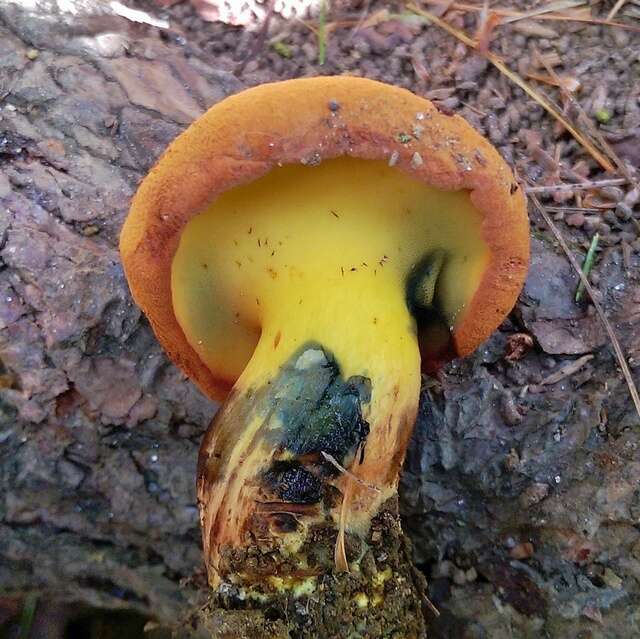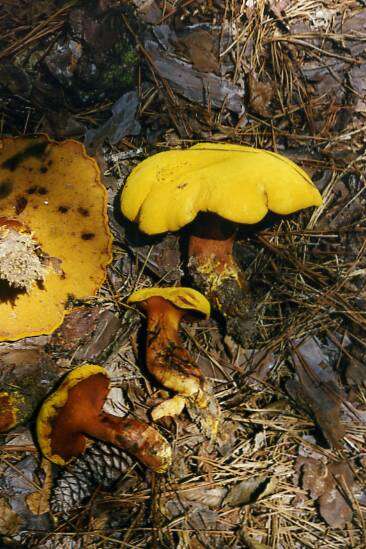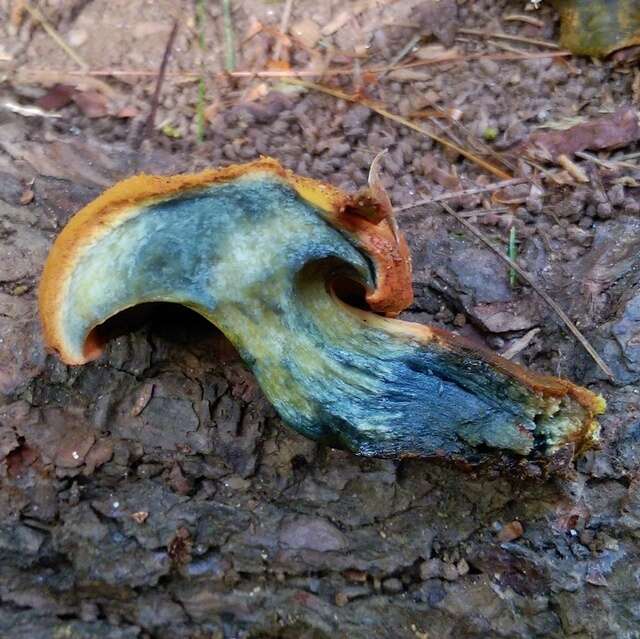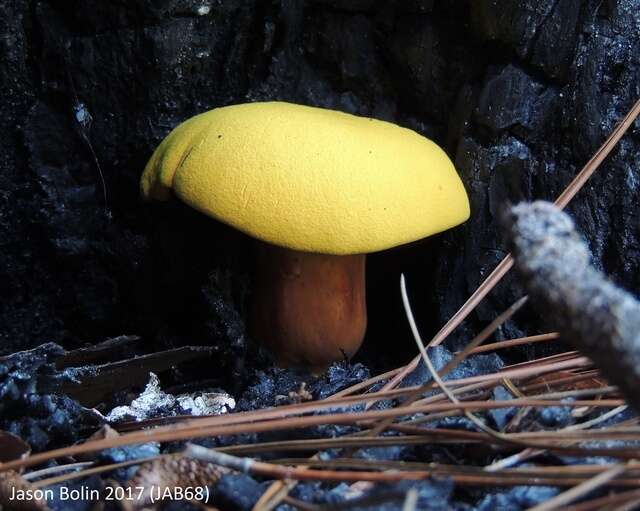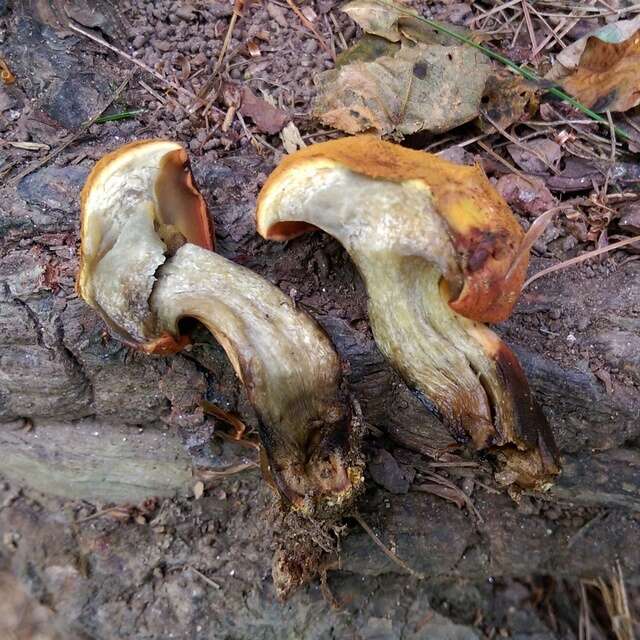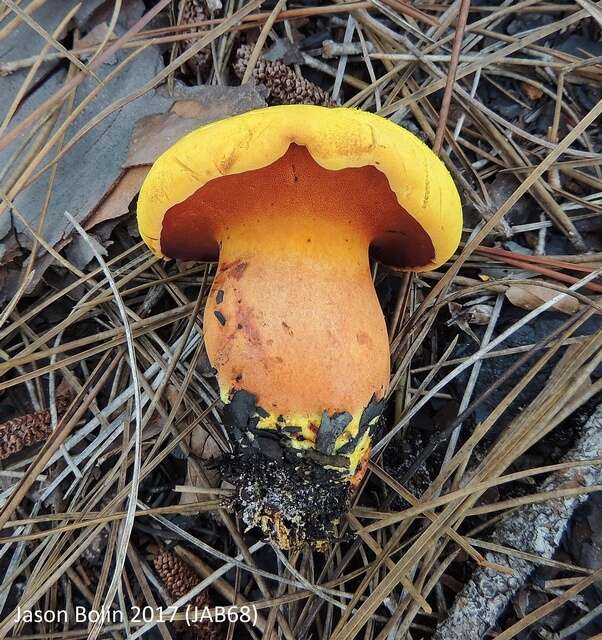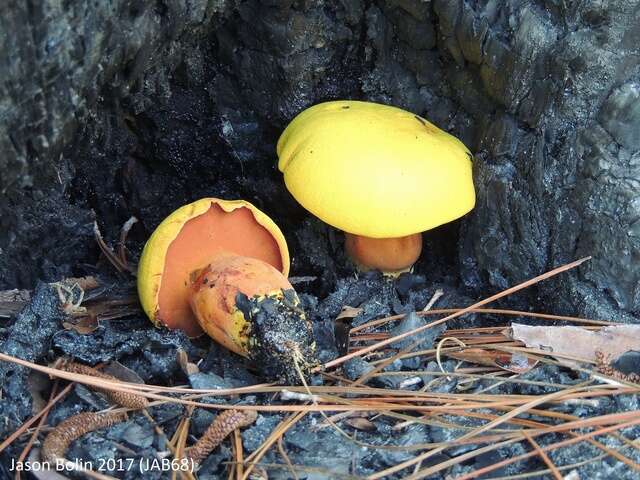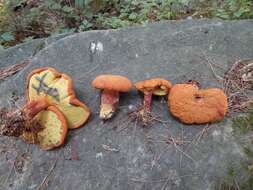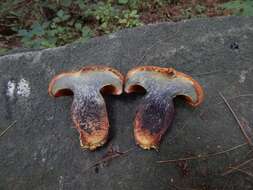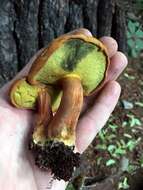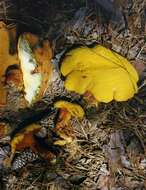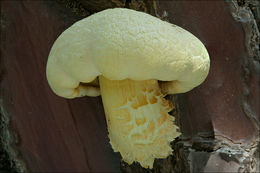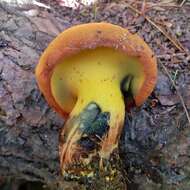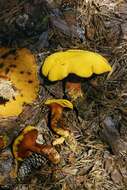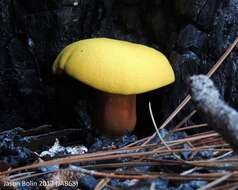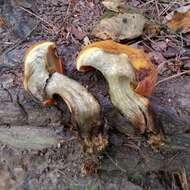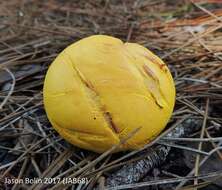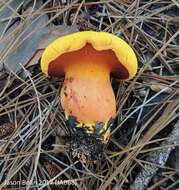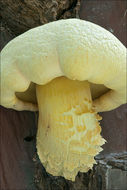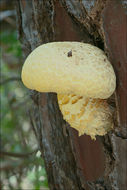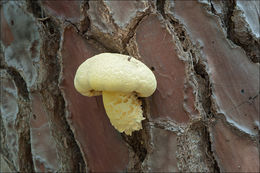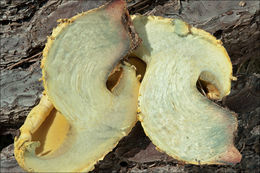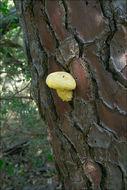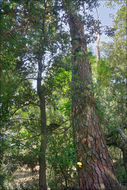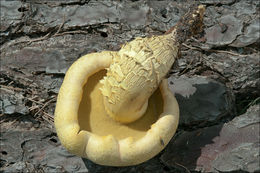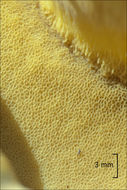-
Mushroom Observer Image 763710: Buchwaldoboletus lignicola (Kallenb.) Pilát
-
Mushroom Observer Image 322920: Buchwaldoboletus hemichrysus (Berk. & M.A. Curtis) Pilát
-
Mushroom Observer Image 763712: Buchwaldoboletus lignicola (Kallenb.) Pilát
-
Mushroom Observer Image 54276: Buchwaldoboletus hemichrysus (Berk. & M.A. Curtis) Pilát
-
Mushroom Observer Image 784338: Buchwaldoboletus lignicola (Kallenb.) Pilát
-
Mushroom Observer Image 54277: Buchwaldoboletus hemichrysus (Berk. & M.A. Curtis) Pilát
-
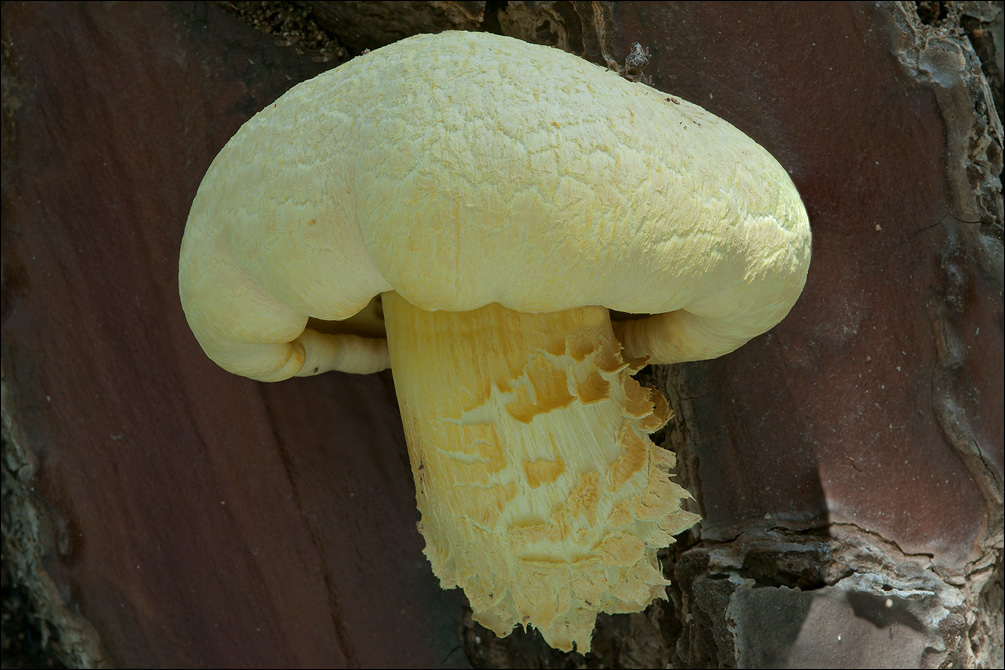
Slo.: jelovi privihanec - syn.: Boletus lignicola Kallenb., Gyrodon lignicola (Kallenb.) Heinem., Phlebopus lignicola (Kallenb.) Moser, Pulveroboletus lignicola (Kallenb.) Dick & Snell, Xerocomus lignicola (Kallenb.) Singer. - Habitat: mixed Mediterranean forest, at the edge of a large group of Pinus pinaster (cf.) trees, almost certainly planted around an old, abandoned villa (in a park); sea shore, south aspect, sandy bedrock; dry, sunny place; in shade; partly protected from direct rain by tree canopies; average precipitations ~ 900 mm/year, average temperature 12-14 deg C, elevation 8 m (25 feet), Mediterranean phytogeographical region.Substratum: large, dead Pinus pinaster (cf.) tree; growing about 80 cm above ground level.Place: Island Rab, north part, near ferryboat harbor to island Krk, Adriatic Sea, Kvarner bay, Croatia EC. Comments: Buchwaldoboletus lignicola is a beautiful fungus and a true rarity. It is protected and on Red lists in many countries, Slovenia included. In some of them it is considered close to extinction. Genus Buchwaldoboletus, which comprises today about 12 species worldwide, was established and separated from genus Boletus in 1969. Three names were relevant in Europe: Buchwaldoboletus hemichrysus (Berk. & M.A. Curtis) Pilt, Buchwaldoboletus sphaerocephalus (Barla) Watling & T.H. Li and Buchwaldoboletus lignicola (Kallenb.) Pilt. Taxonomical history of the genus is complex and at the time (in 1947) these three names (or at least two) were synonymous and put to genus Pulveroboletus. Even today several scholars consider B. hemichrysus and B. sphaerocephalus as synonyms. However, currently Index Fungorum recognizes all three mention names as current species names. B. hemichrysus is considered as an American species (reports from Europe refer to B. sphaerocephalus according to Ref.:11) while B. sphaerocephalus (people who consider B. sphaerocephalus = B. hemichrysus would use the latter name) and B. lignicola are European species. Description of characteristic traits of Buchwaldoboletus lignicola in literature is widely scattered. For example, in the literature given below the color of the hut is described as: beige, brown, brown-ochre, brown-reddish, golden-brown, light brown, ochraceous, ochre-creamy, ochre-yellow, orange yellow, orange-brown, reddish-brown, rusty, rusty-brown, some shade of brown, yellow-brown and yellow-ochre, while for the alternative B. sphaerocephalus/hemychrisus similar colors are given from yellow to brown with the average shifted toward yellow. Obviously, if one finds a single fruitbody, such information is of little help for determination. In addition, this find seems yellow through, which fits best to the description 'completely yellow fruitbody' given in Ref.: 2. Based on this B. sphaerocephalus would seem a better choice.However, Krieglsteiner (2000), Ref.5., p 287 in his key as well as Ortiz-Santana (2011), Ref.12., p 2 both state as an important discriminating trait of B. lignicola a thin gelatinous layer between tomentum and trama of the hut, which is not present in B. sphaerocephalus. This layer was clearly visible in this find. The layer was apparent even during preparation of the cutis for microscopy at low magnification of a dissecting microscope. Also hypha of this layer with no clamps corresponds well to the description in Breitenbach (1991), Ref.2. This led me to believe that the find is B. lignicola. Many other traits fit well to this choice. Yet, several do not. Color of the hut seems too yellow (young fruitbody?), the shape of the stipe is not equal as described for B. lignicola but club shaped, rooted and too thick, observed bluing fits only marginally to the description. Redding of the base of the stipe when cut is mentioned nowhere. Spore dimensions seem OK taking into account wide scatter of data from different sources. Description of the find.Growing solitary; hut 85 mm in diameter, trama 20 mm thick, pore layer up to 8 mm thick; tubes detersible (can be easily separated from trama); pores only slightly decurrent; stipe club shaped and slightly rooting, 8 cm long and up to 4 cm in diameter; fruitbody not bluing when handled, only pores do slightly (blue-green); when cut trama slowly bluing here and there to some extent, mostly in the base of the stipe and above pore layer, rooting part of the stipe changes to reddish; bluing disappears after about half on an hour and trama becomes again pale yellowish; after a day or two pore layer becomes dark brown with olive tint and the whole fruitbody turns darker, muddy yellow-orange-reddish; smell distinctive but not strong, pleasant, mushroomy; taste mild, indistinctive; KOH 5% reaction on pileus and trama distinctive but not violent, reddish-brown; on pored dark reddish-brown, almost black; SP abundant, brown, oac818.Spores smooth, dimensions: (6,4) 6,8 - 7,5 (8) x (3,7) 3,75 - 4,25 (4,3) microns; Q = (1,6) 1,7 - 1,9 (2); N = 30; Me = 7,1 x 4 microns; Qe = 1,8. Simple septa. Olympus CH20, NEA 100x/1.25, magnification 1.000 x, oil (spores); NEA 40x/0.65, magnification 400x (cuticle, hypha), NEA 10x/0.25, magnification 100x (cuticle, hypha), in water, about four days old material, not yet completely dry. AmScope MA500 digital camera.In Slovenia protected according to: Uredba o zavarovanih prostoiveih vrstah gliv, Uradni list RS, t. 58/2011 (Regulation of protected wild fungi, Official Gazette of Republic Slovenia, no. 58/2011), (2011). Also on our Red list.Herbarium: Mycotheca and lichen herbarium (LJU-Li) of Slovenian Forestry Institute, Vena pot 2, Ljubljana, Index Herbariorum LJFRef.: (1) https://www.123pilze.de/DreamHC/Download/Nadelholzroehrling.htm (accessed on Sept. 10. 2017) (2) J. Breitenbach, F. Kraenzlin, Eds., Fungi of Switzerland, Vol.3. Verlag Mykologia (1991), p 76. (3) http://boletales.com/genera/buchwaldoboletus/b-lignicola/ (accessed on Sept. 7. 2017) (4) http://boletales.com/genera/buchwaldoboletus/b-sphaerocephalus/ (accessed on Sept. 7. 2017) (5) G.J. Krieglsteiner (Hrsg.), Die Grosspilze Baden-Wrttembergs, Band 2, Ulmer (2000), p 289 and 291. (6) S. Buczacki, Collins Fungi Guide, Collins (2012), p 408. (7) R. Phillips, Mushrooms, Macmillan (2006), p 283. (8) L. Hagar, Ottova Encyklopedia Hb, Ottova Nakladatelstvi, Praha (2015) (in Slovakian), p 573 and 574.(9) G. Kibby, British Boletes, Copyright Geoffrey Kibby (2011), p 21. (10) http://www.first-nature.com/fungi/buchwaldoboletus-lignicola.php (accessed on Sept. 7. 2017) (11) Blanco-Dios JB, Notes on the genus Buchwaldoboletus in Galicia and North of Portugal, Mycosphere 4 (5): 945950 (2013); available at: http://www.mycosphere.org/pdf/MC4_5_No7.pdf (12) B. Ortiz-Santana, A Preliminary Survey of the Genus Buchwaldoboletus (Boletales: Boletaceae), Bull. Buffalo Soc, of Nat. Sci., Vol. 40. (2011), p 1.
-
Mushroom Observer Image 791937: Buchwaldoboletus lignicola (Kallenb.) Pilát
-
Mushroom Observer Image 54278: Buchwaldoboletus hemichrysus (Berk. & M.A. Curtis) Pilát
-
Mushroom Observer Image 791938: Buchwaldoboletus lignicola (Kallenb.) Pilát
-
Mushroom Observer Image 765531: Buchwaldoboletus hemichrysus (Berk. & M.A. Curtis) Pilát
-
Mushroom Observer Image 791939: Buchwaldoboletus lignicola (Kallenb.) Pilát
-
Mushroom Observer Image 765532: Buchwaldoboletus hemichrysus (Berk. & M.A. Curtis) Pilát
-
Mushroom Observer Image 765533: Buchwaldoboletus hemichrysus (Berk. & M.A. Curtis) Pilát
-
Mushroom Observer Image 765534: Buchwaldoboletus hemichrysus (Berk. & M.A. Curtis) Pilát
-
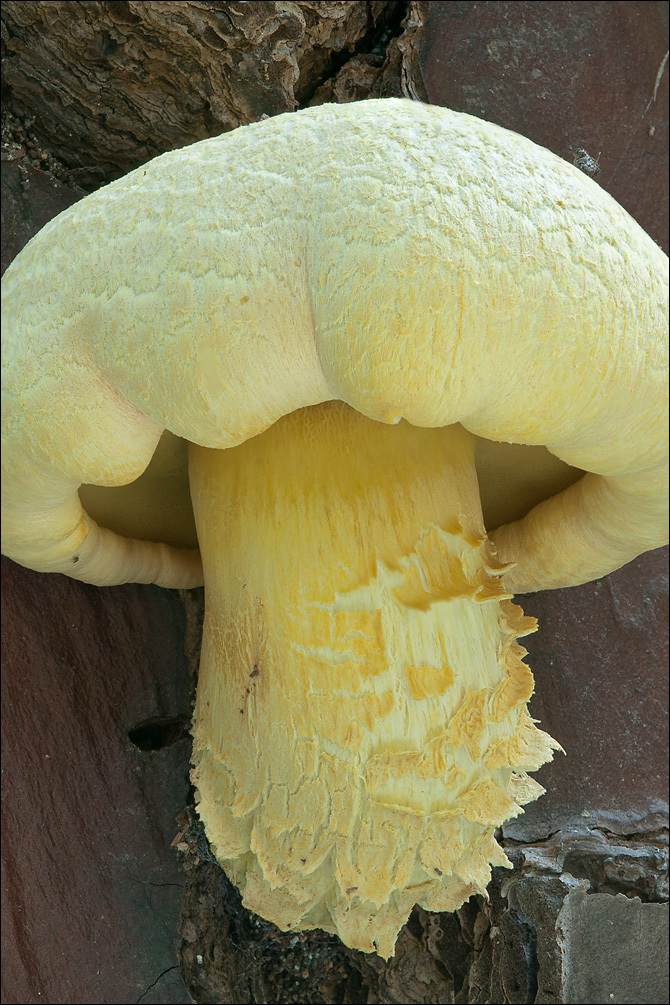
Slo.: jelovi privihanec - syn.: Boletus lignicola Kallenb., Gyrodon lignicola (Kallenb.) Heinem., Phlebopus lignicola (Kallenb.) Moser, Pulveroboletus lignicola (Kallenb.) Dick & Snell, Xerocomus lignicola (Kallenb.) Singer. - Habitat: mixed Mediterranean forest, at the edge of a large group of Pinus pinaster (cf.) trees, almost certainly planted around an old, abandoned villa (in a park); sea shore, south aspect, sandy bedrock; dry, sunny place; in shade; partly protected from direct rain by tree canopies; average precipitations ~ 900 mm/year, average temperature 12-14 deg C, elevation 8 m (25 feet), Mediterranean phytogeographical region. Substratum: large, dead Pinus pinaster (cf.) tree; growing about 80 cm above ground level. Place: Island Rab, north part, near ferryboat harbor to island Krk, Adriatic Sea, Kvarner bay, Croatia EC. Comments: Buchwaldoboletus lignicola is a beautiful fungus and a true rarity. It is protected and on Red lists in many countries, Slovenia included. In some of them it is considered close to extinction. Genus Buchwaldoboletus, which comprises today about 12 species worldwide, was established and separated from genus Boletus in 1969. Three names were relevant in Europe: Buchwaldoboletus hemichrysus (Berk. & M.A. Curtis) Pilt, Buchwaldoboletus sphaerocephalus (Barla) Watling & T.H. Li and Buchwaldoboletus lignicola (Kallenb.) Pilt. Taxonomical history of the genus is complex and at the time (in 1947) these three names (or at least two) were synonymous and put to genus Pulveroboletus. Even today several scholars consider B. hemichrysus and B. sphaerocephalus as synonyms. However, currently Index Fungorum recognizes all three mention names as current species names. B. hemichrysus is considered as an American species (reports from Europe refer to B. sphaerocephalus according to Ref.:11) while B. sphaerocephalus (people who consider B. sphaerocephalus = B. hemichrysus would use the latter name) and B. lignicola are European species. Description of characteristic traits of Buchwaldoboletus lignicola in literature is widely scattered. For example, in the literature given below the color of the hut is described as: beige, brown, brown-ochre, brown-reddish, golden-brown, light brown, ochraceous, ochre-creamy, ochre-yellow, orange yellow, orange-brown, reddish-brown, rusty, rusty-brown, some shade of brown, yellow-brown and yellow-ochre, while for the alternative B. sphaerocephalus/hemychrisus similar colors are given from yellow to brown with the average shifted toward yellow. Obviously, if one finds a single fruitbody, such information is of little help for determination. In addition, this find seems yellow through, which fits best to the description 'completely yellow fruitbody' given in Ref.: 2. Based on this B. sphaerocephalus would seem a better choice. However, Krieglsteiner (2000), Ref.5., p 287 in his key as well as Ortiz-Santana (2011), Ref.12., p 2 both state as an important discriminating trait of B. lignicola a thin gelatinous layer between tomentum and trama of the hut, which is not present in B. sphaerocephalus. This layer was clearly visible in this find. The layer was apparent even during preparation of the cutis for microscopy at low magnification of a dissecting microscope. Also hypha of this layer with no clamps corresponds well to the description in Breitenbach (1991), Ref.2. This led me to believe that the find is B. lignicola. Many other traits fit well to this choice. Yet, several do not. Color of the hut seems too yellow (young fruitbody?), the shape of the stipe is not equal as described for B. lignicola but club shaped, rooted and too thick, observed bluing fits only marginally to the description. Redding of the base of the stipe when cut is mentioned nowhere. Spore dimensions seem OK taking into account wide scatter of data from different sources. Description of the find. Growing solitary; hut 85 mm in diameter, trama 20 mm thick, pore layer up to 8 mm thick; tubes detersible (can be easily separated from trama); pores only slightly decurrent; stipe club shaped and slightly rooting, 8 cm long and up to 4 cm in diameter; fruitbody not bluing when handled, only pores do slightly (blue-green); when cut trama slowly bluing here and there to some extent, mostly in the base of the stipe and above pore layer, rooting part of the stipe changes to reddish; bluing disappears after about half on an hour and trama becomes again pale yellowish; after a day or two pore layer becomes dark brown with olive tint and the whole fruitbody turns darker, muddy yellow-orange-reddish; smell distinctive but not strong, pleasant, mushroomy; taste mild, indistinctive; KOH 5% reaction on pileus and trama distinctive but not violent, reddish-brown; on pored dark reddish-brown, almost black; SP abundant, brown, oac818. Spores smooth, dimensions: (6,4) 6,8 - 7,5 (8) x (3,7) 3,75 - 4,25 (4,3) microns; Q = (1,6) 1,7 - 1,9 (2); N = 30; Me = 7,1 x 4 microns; Qe = 1,8. Simple septa. Olympus CH20, NEA 100x/1.25, magnification 1.000 x, oil (spores); NEA 40x/0.65, magnification 400x (cuticle, hypha), NEA 10x/0.25, magnification 100x (cuticle, hypha), in water, about four days old material, not yet completely dry. AmScope MA500 digital camera. In Slovenia protected according to: Uredba o zavarovanih prostoiveih vrstah gliv, Uradni list RS, t. 58/2011 (Regulation of protected wild fungi, Official Gazette of Republic Slovenia, no. 58/2011), (2011). Also on our Red list. Herbarium: Mycotheca and lichen herbarium (LJU-Li) of Slovenian Forestry Institute, Vena pot 2, Ljubljana, Index Herbariorum LJF Ref.: (1) https://www.123pilze.de/DreamHC/Download/Nadelholzroehrling.htm (accessed on Sept. 10. 2017) (2) J. Breitenbach, F. Kraenzlin, Eds., Fungi of Switzerland, Vol.3. Verlag Mykologia (1991), p 76. (3) http://boletales.com/genera/buchwaldoboletus/b-lignicola/ (accessed on Sept. 7. 2017) (4) http://boletales.com/genera/buchwaldoboletus/b-sphaerocephalus/ (accessed on Sept. 7. 2017) (5) G.J. Krieglsteiner (Hrsg.), Die Grosspilze Baden-Wrttembergs, Band 2, Ulmer (2000), p 289 and 291. (6) S. Buczacki, Collins Fungi Guide, Collins (2012), p 408. (7) R. Phillips, Mushrooms, Macmillan (2006), p 283. (8) L. Hagar, Ottova Encyklopedia Hb, Ottova Nakladatelstvi, Praha (2015) (in Slovakian), p 573 and 574. (9) G. Kibby, British Boletes, Copyright Geoffrey Kibby (2011), p 21. (10) http://www.first-nature.com/fungi/buchwaldoboletus-lignicola.php (accessed on Sept. 7. 2017) (11) Blanco-Dios JB, Notes on the genus Buchwaldoboletus in Galicia and North of Portugal, Mycosphere 4 (5): 945950 (2013); available at: http://www.mycosphere.org/pdf/MC4_5_No7.pdf (12) B. Ortiz-Santana, A Preliminary Survey of the Genus Buchwaldoboletus (Boletales: Boletaceae), Bull. Buffalo Soc, of Nat. Sci., Vol. 40. (2011), p 1.
-

Slo.: jelovi privihanec - syn.: Boletus lignicola Kallenb., Gyrodon lignicola (Kallenb.) Heinem., Phlebopus lignicola (Kallenb.) Moser, Pulveroboletus lignicola (Kallenb.) Dick & Snell, Xerocomus lignicola (Kallenb.) Singer. - Habitat: mixed Mediterranean forest, at the edge of a large group of Pinus pinaster (cf.) trees, almost certainly planted around an old, abandoned villa (in a park); sea shore, south aspect, sandy bedrock; dry, sunny place; in shade; partly protected from direct rain by tree canopies; average precipitations ~ 900 mm/year, average temperature 12-14 deg C, elevation 8 m (25 feet), Mediterranean phytogeographical region. Substratum: large, dead Pinus pinaster (cf.) tree; growing about 80 cm above ground level. Place: Island Rab, north part, near ferryboat harbor to island Krk, Adriatic Sea, Kvarner bay, Croatia EC. Comments: Buchwaldoboletus lignicola is a beautiful fungus and a true rarity. It is protected and on Red lists in many countries, Slovenia included. In some of them it is considered close to extinction. Genus Buchwaldoboletus, which comprises today about 12 species worldwide, was established and separated from genus Boletus in 1969. Three names were relevant in Europe: Buchwaldoboletus hemichrysus (Berk. & M.A. Curtis) Pilt, Buchwaldoboletus sphaerocephalus (Barla) Watling & T.H. Li and Buchwaldoboletus lignicola (Kallenb.) Pilt. Taxonomical history of the genus is complex and at the time (in 1947) these three names (or at least two) were synonymous and put to genus Pulveroboletus. Even today several scholars consider B. hemichrysus and B. sphaerocephalus as synonyms. However, currently Index Fungorum recognizes all three mention names as current species names. B. hemichrysus is considered as an American species (reports from Europe refer to B. sphaerocephalus according to Ref.:11) while B. sphaerocephalus (people who consider B. sphaerocephalus = B. hemichrysus would use the latter name) and B. lignicola are European species. Description of characteristic traits of Buchwaldoboletus lignicola in literature is widely scattered. For example, in the literature given below the color of the hut is described as: beige, brown, brown-ochre, brown-reddish, golden-brown, light brown, ochraceous, ochre-creamy, ochre-yellow, orange yellow, orange-brown, reddish-brown, rusty, rusty-brown, some shade of brown, yellow-brown and yellow-ochre, while for the alternative B. sphaerocephalus/hemychrisus similar colors are given from yellow to brown with the average shifted toward yellow. Obviously, if one finds a single fruitbody, such information is of little help for determination. In addition, this find seems yellow through, which fits best to the description 'completely yellow fruitbody' given in Ref.: 2. Based on this B. sphaerocephalus would seem a better choice. However, Krieglsteiner (2000), Ref.5., p 287 in his key as well as Ortiz-Santana (2011), Ref.12., p 2 both state as an important discriminating trait of B. lignicola a thin gelatinous layer between tomentum and trama of the hut, which is not present in B. sphaerocephalus. This layer was clearly visible in this find. The layer was apparent even during preparation of the cutis for microscopy at low magnification of a dissecting microscope. Also hypha of this layer with no clamps corresponds well to the description in Breitenbach (1991), Ref.2. This led me to believe that the find is B. lignicola. Many other traits fit well to this choice. Yet, several do not. Color of the hut seems too yellow (young fruitbody?), the shape of the stipe is not equal as described for B. lignicola but club shaped, rooted and too thick, observed bluing fits only marginally to the description. Redding of the base of the stipe when cut is mentioned nowhere. Spore dimensions seem OK taking into account wide scatter of data from different sources. Description of the find. Growing solitary; hut 85 mm in diameter, trama 20 mm thick, pore layer up to 8 mm thick; tubes detersible (can be easily separated from trama); pores only slightly decurrent; stipe club shaped and slightly rooting, 8 cm long and up to 4 cm in diameter; fruitbody not bluing when handled, only pores do slightly (blue-green); when cut trama slowly bluing here and there to some extent, mostly in the base of the stipe and above pore layer, rooting part of the stipe changes to reddish; bluing disappears after about half on an hour and trama becomes again pale yellowish; after a day or two pore layer becomes dark brown with olive tint and the whole fruitbody turns darker, muddy yellow-orange-reddish; smell distinctive but not strong, pleasant, mushroomy; taste mild, indistinctive; KOH 5% reaction on pileus and trama distinctive but not violent, reddish-brown; on pored dark reddish-brown, almost black; SP abundant, brown, oac818. Spores smooth, dimensions: (6,4) 6,8 - 7,5 (8) x (3,7) 3,75 - 4,25 (4,3) microns; Q = (1,6) 1,7 - 1,9 (2); N = 30; Me = 7,1 x 4 microns; Qe = 1,8. Simple septa. Olympus CH20, NEA 100x/1.25, magnification 1.000 x, oil (spores); NEA 40x/0.65, magnification 400x (cuticle, hypha), NEA 10x/0.25, magnification 100x (cuticle, hypha), in water, about four days old material, not yet completely dry. AmScope MA500 digital camera. In Slovenia protected according to: Uredba o zavarovanih prostoiveih vrstah gliv, Uradni list RS, t. 58/2011 (Regulation of protected wild fungi, Official Gazette of Republic Slovenia, no. 58/2011), (2011). Also on our Red list. Herbarium: Mycotheca and lichen herbarium (LJU-Li) of Slovenian Forestry Institute, Vena pot 2, Ljubljana, Index Herbariorum LJF Ref.: (1) https://www.123pilze.de/DreamHC/Download/Nadelholzroehrling.htm (accessed on Sept. 10. 2017) (2) J. Breitenbach, F. Kraenzlin, Eds., Fungi of Switzerland, Vol.3. Verlag Mykologia (1991), p 76. (3) http://boletales.com/genera/buchwaldoboletus/b-lignicola/ (accessed on Sept. 7. 2017) (4) http://boletales.com/genera/buchwaldoboletus/b-sphaerocephalus/ (accessed on Sept. 7. 2017) (5) G.J. Krieglsteiner (Hrsg.), Die Grosspilze Baden-Wrttembergs, Band 2, Ulmer (2000), p 289 and 291. (6) S. Buczacki, Collins Fungi Guide, Collins (2012), p 408. (7) R. Phillips, Mushrooms, Macmillan (2006), p 283. (8) L. Hagar, Ottova Encyklopedia Hb, Ottova Nakladatelstvi, Praha (2015) (in Slovakian), p 573 and 574. (9) G. Kibby, British Boletes, Copyright Geoffrey Kibby (2011), p 21. (10) http://www.first-nature.com/fungi/buchwaldoboletus-lignicola.php (accessed on Sept. 7. 2017) (11) Blanco-Dios JB, Notes on the genus Buchwaldoboletus in Galicia and North of Portugal, Mycosphere 4 (5): 945950 (2013); available at: http://www.mycosphere.org/pdf/MC4_5_No7.pdf (12) B. Ortiz-Santana, A Preliminary Survey of the Genus Buchwaldoboletus (Boletales: Boletaceae), Bull. Buffalo Soc, of Nat. Sci., Vol. 40. (2011), p 1.
-
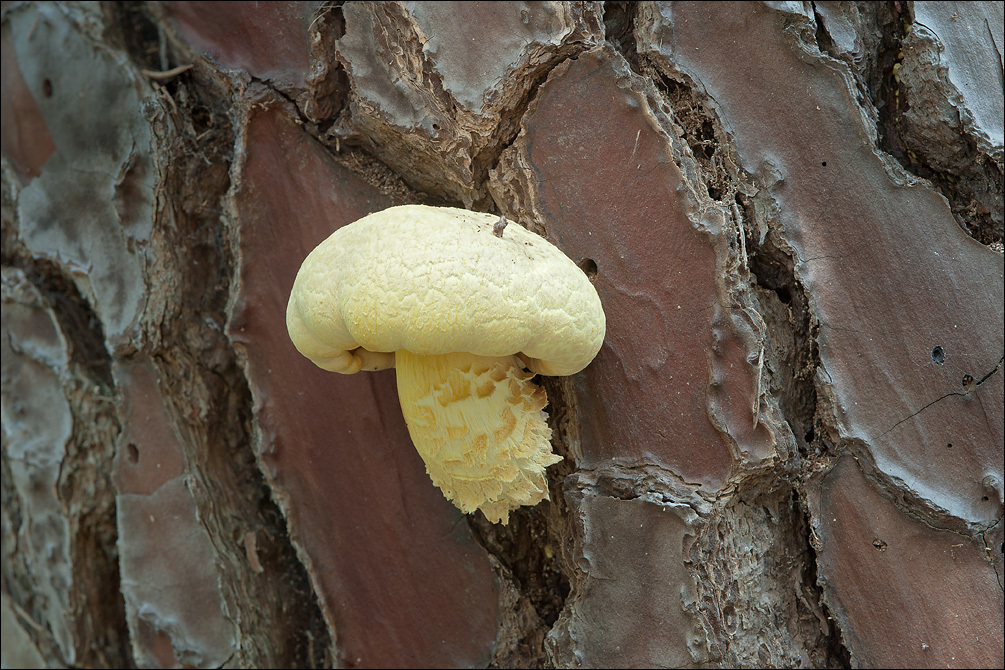
Slo.: jelovi privihanec - syn.: Boletus lignicola Kallenb., Gyrodon lignicola (Kallenb.) Heinem., Phlebopus lignicola (Kallenb.) Moser, Pulveroboletus lignicola (Kallenb.) Dick & Snell, Xerocomus lignicola (Kallenb.) Singer. - Habitat: mixed Mediterranean forest, at the edge of a large group of Pinus pinaster (cf.) trees, almost certainly planted around an old, abandoned villa (in a park); sea shore, south aspect, sandy bedrock; dry, sunny place; in shade; partly protected from direct rain by tree canopies; average precipitations ~ 900 mm/year, average temperature 12-14 deg C, elevation 8 m (25 feet), Mediterranean phytogeographical region. Substratum: large, dead Pinus pinaster (cf.) tree; growing about 80 cm above ground level. Place: Island Rab, north part, near ferryboat harbor to island Krk, Adriatic Sea, Kvarner bay, Croatia EC. Comments: Buchwaldoboletus lignicola is a beautiful fungus and a true rarity. It is protected and on Red lists in many countries, Slovenia included. In some of them it is considered close to extinction. Genus Buchwaldoboletus, which comprises today about 12 species worldwide, was established and separated from genus Boletus in 1969. Three names were relevant in Europe: Buchwaldoboletus hemichrysus (Berk. & M.A. Curtis) Pilt, Buchwaldoboletus sphaerocephalus (Barla) Watling & T.H. Li and Buchwaldoboletus lignicola (Kallenb.) Pilt. Taxonomical history of the genus is complex and at the time (in 1947) these three names (or at least two) were synonymous and put to genus Pulveroboletus. Even today several scholars consider B. hemichrysus and B. sphaerocephalus as synonyms. However, currently Index Fungorum recognizes all three mention names as current species names. B. hemichrysus is considered as an American species (reports from Europe refer to B. sphaerocephalus according to Ref.:11) while B. sphaerocephalus (people who consider B. sphaerocephalus = B. hemichrysus would use the latter name) and B. lignicola are European species. Description of characteristic traits of Buchwaldoboletus lignicola in literature is widely scattered. For example, in the literature given below the color of the hut is described as: beige, brown, brown-ochre, brown-reddish, golden-brown, light brown, ochraceous, ochre-creamy, ochre-yellow, orange yellow, orange-brown, reddish-brown, rusty, rusty-brown, some shade of brown, yellow-brown and yellow-ochre, while for the alternative B. sphaerocephalus/hemychrisus similar colors are given from yellow to brown with the average shifted toward yellow. Obviously, if one finds a single fruitbody, such information is of little help for determination. In addition, this find seems yellow through, which fits best to the description 'completely yellow fruitbody' given in Ref.: 2. Based on this B. sphaerocephalus would seem a better choice. However, Krieglsteiner (2000), Ref.5., p 287 in his key as well as Ortiz-Santana (2011), Ref.12., p 2 both state as an important discriminating trait of B. lignicola a thin gelatinous layer between tomentum and trama of the hut, which is not present in B. sphaerocephalus. This layer was clearly visible in this find. The layer was apparent even during preparation of the cutis for microscopy at low magnification of a dissecting microscope. Also hypha of this layer with no clamps corresponds well to the description in Breitenbach (1991), Ref.2. This led me to believe that the find is B. lignicola. Many other traits fit well to this choice. Yet, several do not. Color of the hut seems too yellow (young fruitbody?), the shape of the stipe is not equal as described for B. lignicola but club shaped, rooted and too thick, observed bluing fits only marginally to the description. Redding of the base of the stipe when cut is mentioned nowhere. Spore dimensions seem OK taking into account wide scatter of data from different sources. Description of the find. Growing solitary; hut 85 mm in diameter, trama 20 mm thick, pore layer up to 8 mm thick; tubes detersible (can be easily separated from trama); pores only slightly decurrent; stipe club shaped and slightly rooting, 8 cm long and up to 4 cm in diameter; fruitbody not bluing when handled, only pores do slightly (blue-green); when cut trama slowly bluing here and there to some extent, mostly in the base of the stipe and above pore layer, rooting part of the stipe changes to reddish; bluing disappears after about half on an hour and trama becomes again pale yellowish; after a day or two pore layer becomes dark brown with olive tint and the whole fruitbody turns darker, muddy yellow-orange-reddish; smell distinctive but not strong, pleasant, mushroomy; taste mild, indistinctive; KOH 5% reaction on pileus and trama distinctive but not violent, reddish-brown; on pored dark reddish-brown, almost black; SP abundant, brown, oac818. Spores smooth, dimensions: (6,4) 6,8 - 7,5 (8) x (3,7) 3,75 - 4,25 (4,3) microns; Q = (1,6) 1,7 - 1,9 (2); N = 30; Me = 7,1 x 4 microns; Qe = 1,8. Simple septa. Olympus CH20, NEA 100x/1.25, magnification 1.000 x, oil (spores); NEA 40x/0.65, magnification 400x (cuticle, hypha), NEA 10x/0.25, magnification 100x (cuticle, hypha), in water, about four days old material, not yet completely dry. AmScope MA500 digital camera. In Slovenia protected according to: Uredba o zavarovanih prostoiveih vrstah gliv, Uradni list RS, t. 58/2011 (Regulation of protected wild fungi, Official Gazette of Republic Slovenia, no. 58/2011), (2011). Also on our Red list. Herbarium: Mycotheca and lichen herbarium (LJU-Li) of Slovenian Forestry Institute, Vena pot 2, Ljubljana, Index Herbariorum LJF Ref.: (1) https://www.123pilze.de/DreamHC/Download/Nadelholzroehrling.htm (accessed on Sept. 10. 2017) (2) J. Breitenbach, F. Kraenzlin, Eds., Fungi of Switzerland, Vol.3. Verlag Mykologia (1991), p 76. (3) http://boletales.com/genera/buchwaldoboletus/b-lignicola/ (accessed on Sept. 7. 2017) (4) http://boletales.com/genera/buchwaldoboletus/b-sphaerocephalus/ (accessed on Sept. 7. 2017) (5) G.J. Krieglsteiner (Hrsg.), Die Grosspilze Baden-Wrttembergs, Band 2, Ulmer (2000), p 289 and 291. (6) S. Buczacki, Collins Fungi Guide, Collins (2012), p 408. (7) R. Phillips, Mushrooms, Macmillan (2006), p 283. (8) L. Hagar, Ottova Encyklopedia Hb, Ottova Nakladatelstvi, Praha (2015) (in Slovakian), p 573 and 574. (9) G. Kibby, British Boletes, Copyright Geoffrey Kibby (2011), p 21. (10) http://www.first-nature.com/fungi/buchwaldoboletus-lignicola.php (accessed on Sept. 7. 2017) (11) Blanco-Dios JB, Notes on the genus Buchwaldoboletus in Galicia and North of Portugal, Mycosphere 4 (5): 945950 (2013); available at: http://www.mycosphere.org/pdf/MC4_5_No7.pdf (12) B. Ortiz-Santana, A Preliminary Survey of the Genus Buchwaldoboletus (Boletales: Boletaceae), Bull. Buffalo Soc, of Nat. Sci., Vol. 40. (2011), p 1.
-
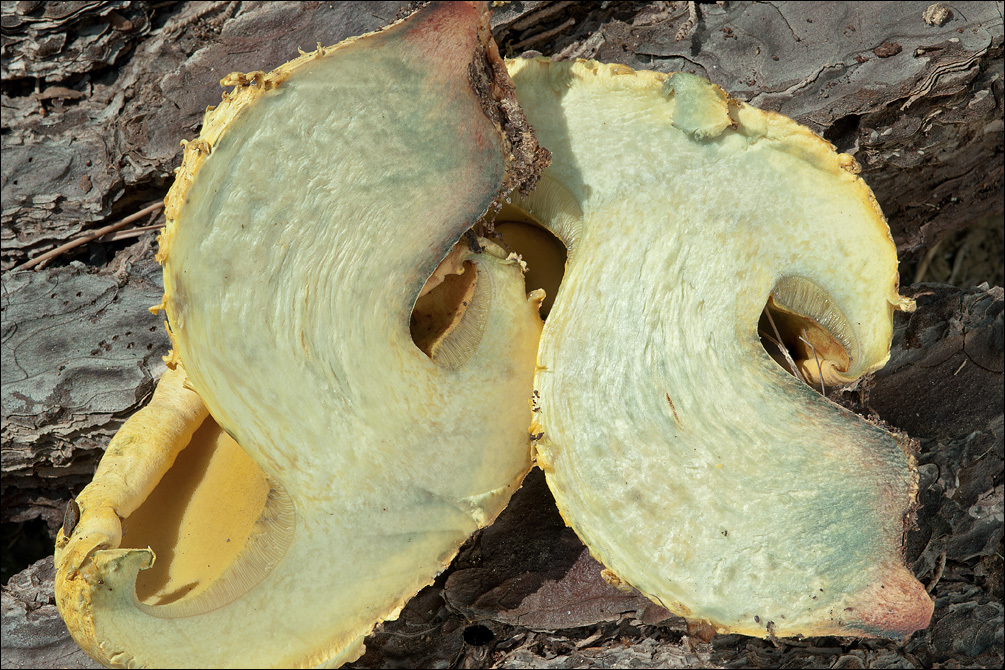
Slo.: jelovi privihanec - syn.: Boletus lignicola Kallenb., Gyrodon lignicola (Kallenb.) Heinem., Phlebopus lignicola (Kallenb.) Moser, Pulveroboletus lignicola (Kallenb.) Dick & Snell, Xerocomus lignicola (Kallenb.) Singer. - Habitat: mixed Mediterranean forest, at the edge of a large group of Pinus pinaster (cf.) trees, almost certainly planted around an old, abandoned villa (in a park); sea shore, south aspect, sandy bedrock; dry, sunny place; in shade; partly protected from direct rain by tree canopies; average precipitations ~ 900 mm/year, average temperature 12-14 deg C, elevation 8 m (25 feet), Mediterranean phytogeographical region. Substratum: large, dead Pinus pinaster (cf.) tree; growing about 80 cm above ground level. Place: Island Rab, north part, near ferryboat harbor to island Krk, Adriatic Sea, Kvarner bay, Croatia EC. Comments: Buchwaldoboletus lignicola is a beautiful fungus and a true rarity. It is protected and on Red lists in many countries, Slovenia included. In some of them it is considered close to extinction. Genus Buchwaldoboletus, which comprises today about 12 species worldwide, was established and separated from genus Boletus in 1969. Three names were relevant in Europe: Buchwaldoboletus hemichrysus (Berk. & M.A. Curtis) Pilt, Buchwaldoboletus sphaerocephalus (Barla) Watling & T.H. Li and Buchwaldoboletus lignicola (Kallenb.) Pilt. Taxonomical history of the genus is complex and at the time (in 1947) these three names (or at least two) were synonymous and put to genus Pulveroboletus. Even today several scholars consider B. hemichrysus and B. sphaerocephalus as synonyms. However, currently Index Fungorum recognizes all three mention names as current species names. B. hemichrysus is considered as an American species (reports from Europe refer to B. sphaerocephalus according to Ref.:11) while B. sphaerocephalus (people who consider B. sphaerocephalus = B. hemichrysus would use the latter name) and B. lignicola are European species. Description of characteristic traits of Buchwaldoboletus lignicola in literature is widely scattered. For example, in the literature given below the color of the hut is described as: beige, brown, brown-ochre, brown-reddish, golden-brown, light brown, ochraceous, ochre-creamy, ochre-yellow, orange yellow, orange-brown, reddish-brown, rusty, rusty-brown, some shade of brown, yellow-brown and yellow-ochre, while for the alternative B. sphaerocephalus/hemychrisus similar colors are given from yellow to brown with the average shifted toward yellow. Obviously, if one finds a single fruitbody, such information is of little help for determination. In addition, this find seems yellow through, which fits best to the description 'completely yellow fruitbody' given in Ref.: 2. Based on this B. sphaerocephalus would seem a better choice. However, Krieglsteiner (2000), Ref.5., p 287 in his key as well as Ortiz-Santana (2011), Ref.12., p 2 both state as an important discriminating trait of B. lignicola a thin gelatinous layer between tomentum and trama of the hut, which is not present in B. sphaerocephalus. This layer was clearly visible in this find. The layer was apparent even during preparation of the cutis for microscopy at low magnification of a dissecting microscope. Also hypha of this layer with no clamps corresponds well to the description in Breitenbach (1991), Ref.2. This led me to believe that the find is B. lignicola. Many other traits fit well to this choice. Yet, several do not. Color of the hut seems too yellow (young fruitbody?), the shape of the stipe is not equal as described for B. lignicola but club shaped, rooted and too thick, observed bluing fits only marginally to the description. Redding of the base of the stipe when cut is mentioned nowhere. Spore dimensions seem OK taking into account wide scatter of data from different sources. Description of the find. Growing solitary; hut 85 mm in diameter, trama 20 mm thick, pore layer up to 8 mm thick; tubes detersible (can be easily separated from trama); pores only slightly decurrent; stipe club shaped and slightly rooting, 8 cm long and up to 4 cm in diameter; fruitbody not bluing when handled, only pores do slightly (blue-green); when cut trama slowly bluing here and there to some extent, mostly in the base of the stipe and above pore layer, rooting part of the stipe changes to reddish; bluing disappears after about half on an hour and trama becomes again pale yellowish; after a day or two pore layer becomes dark brown with olive tint and the whole fruitbody turns darker, muddy yellow-orange-reddish; smell distinctive but not strong, pleasant, mushroomy; taste mild, indistinctive; KOH 5% reaction on pileus and trama distinctive but not violent, reddish-brown; on pored dark reddish-brown, almost black; SP abundant, brown, oac818. Spores smooth, dimensions: (6,4) 6,8 - 7,5 (8) x (3,7) 3,75 - 4,25 (4,3) microns; Q = (1,6) 1,7 - 1,9 (2); N = 30; Me = 7,1 x 4 microns; Qe = 1,8. Simple septa. Olympus CH20, NEA 100x/1.25, magnification 1.000 x, oil (spores); NEA 40x/0.65, magnification 400x (cuticle, hypha), NEA 10x/0.25, magnification 100x (cuticle, hypha), in water, about four days old material, not yet completely dry. AmScope MA500 digital camera. In Slovenia protected according to: Uredba o zavarovanih prostoiveih vrstah gliv, Uradni list RS, t. 58/2011 (Regulation of protected wild fungi, Official Gazette of Republic Slovenia, no. 58/2011), (2011). Also on our Red list. Herbarium: Mycotheca and lichen herbarium (LJU-Li) of Slovenian Forestry Institute, Vena pot 2, Ljubljana, Index Herbariorum LJF Ref.: (1) https://www.123pilze.de/DreamHC/Download/Nadelholzroehrling.htm (accessed on Sept. 10. 2017) (2) J. Breitenbach, F. Kraenzlin, Eds., Fungi of Switzerland, Vol.3. Verlag Mykologia (1991), p 76. (3) http://boletales.com/genera/buchwaldoboletus/b-lignicola/ (accessed on Sept. 7. 2017) (4) http://boletales.com/genera/buchwaldoboletus/b-sphaerocephalus/ (accessed on Sept. 7. 2017) (5) G.J. Krieglsteiner (Hrsg.), Die Grosspilze Baden-Wrttembergs, Band 2, Ulmer (2000), p 289 and 291. (6) S. Buczacki, Collins Fungi Guide, Collins (2012), p 408. (7) R. Phillips, Mushrooms, Macmillan (2006), p 283. (8) L. Hagar, Ottova Encyklopedia Hb, Ottova Nakladatelstvi, Praha (2015) (in Slovakian), p 573 and 574. (9) G. Kibby, British Boletes, Copyright Geoffrey Kibby (2011), p 21. (10) http://www.first-nature.com/fungi/buchwaldoboletus-lignicola.php (accessed on Sept. 7. 2017) (11) Blanco-Dios JB, Notes on the genus Buchwaldoboletus in Galicia and North of Portugal, Mycosphere 4 (5): 945950 (2013); available at: http://www.mycosphere.org/pdf/MC4_5_No7.pdf (12) B. Ortiz-Santana, A Preliminary Survey of the Genus Buchwaldoboletus (Boletales: Boletaceae), Bull. Buffalo Soc, of Nat. Sci., Vol. 40. (2011), p 1.
-
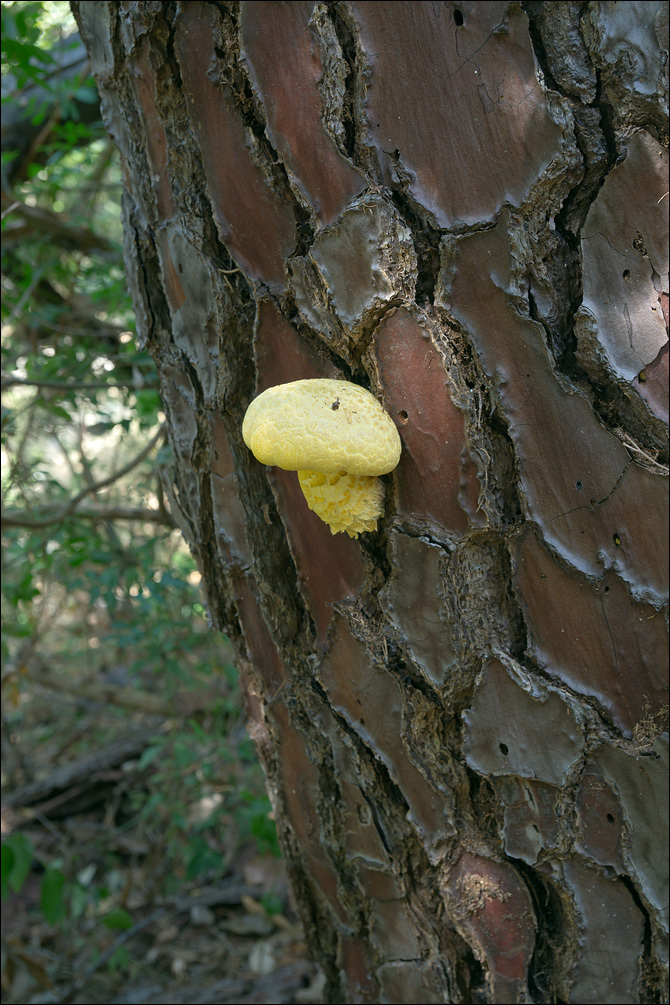
Slo.: jelovi privihanec - syn.: Boletus lignicola Kallenb., Gyrodon lignicola (Kallenb.) Heinem., Phlebopus lignicola (Kallenb.) Moser, Pulveroboletus lignicola (Kallenb.) Dick & Snell, Xerocomus lignicola (Kallenb.) Singer. - Habitat: mixed Mediterranean forest, at the edge of a large group of Pinus pinaster (cf.) trees, almost certainly planted around an old, abandoned villa (in a park); sea shore, south aspect, sandy bedrock; dry, sunny place; in shade; partly protected from direct rain by tree canopies; average precipitations ~ 900 mm/year, average temperature 12-14 deg C, elevation 8 m (25 feet), Mediterranean phytogeographical region. Substratum: large, dead Pinus pinaster (cf.) tree; growing about 80 cm above ground level. Place: Island Rab, north part, near ferryboat harbor to island Krk, Adriatic Sea, Kvarner bay, Croatia EC. Comments: Buchwaldoboletus lignicola is a beautiful fungus and a true rarity. It is protected and on Red lists in many countries, Slovenia included. In some of them it is considered close to extinction. Genus Buchwaldoboletus, which comprises today about 12 species worldwide, was established and separated from genus Boletus in 1969. Three names were relevant in Europe: Buchwaldoboletus hemichrysus (Berk. & M.A. Curtis) Pilt, Buchwaldoboletus sphaerocephalus (Barla) Watling & T.H. Li and Buchwaldoboletus lignicola (Kallenb.) Pilt. Taxonomical history of the genus is complex and at the time (in 1947) these three names (or at least two) were synonymous and put to genus Pulveroboletus. Even today several scholars consider B. hemichrysus and B. sphaerocephalus as synonyms. However, currently Index Fungorum recognizes all three mention names as current species names. B. hemichrysus is considered as an American species (reports from Europe refer to B. sphaerocephalus according to Ref.:11) while B. sphaerocephalus (people who consider B. sphaerocephalus = B. hemichrysus would use the latter name) and B. lignicola are European species. Description of characteristic traits of Buchwaldoboletus lignicola in literature is widely scattered. For example, in the literature given below the color of the hut is described as: beige, brown, brown-ochre, brown-reddish, golden-brown, light brown, ochraceous, ochre-creamy, ochre-yellow, orange yellow, orange-brown, reddish-brown, rusty, rusty-brown, some shade of brown, yellow-brown and yellow-ochre, while for the alternative B. sphaerocephalus/hemychrisus similar colors are given from yellow to brown with the average shifted toward yellow. Obviously, if one finds a single fruitbody, such information is of little help for determination. In addition, this find seems yellow through, which fits best to the description 'completely yellow fruitbody' given in Ref.: 2. Based on this B. sphaerocephalus would seem a better choice. However, Krieglsteiner (2000), Ref.5., p 287 in his key as well as Ortiz-Santana (2011), Ref.12., p 2 both state as an important discriminating trait of B. lignicola a thin gelatinous layer between tomentum and trama of the hut, which is not present in B. sphaerocephalus. This layer was clearly visible in this find. The layer was apparent even during preparation of the cutis for microscopy at low magnification of a dissecting microscope. Also hypha of this layer with no clamps corresponds well to the description in Breitenbach (1991), Ref.2. This led me to believe that the find is B. lignicola. Many other traits fit well to this choice. Yet, several do not. Color of the hut seems too yellow (young fruitbody?), the shape of the stipe is not equal as described for B. lignicola but club shaped, rooted and too thick, observed bluing fits only marginally to the description. Redding of the base of the stipe when cut is mentioned nowhere. Spore dimensions seem OK taking into account wide scatter of data from different sources. Description of the find. Growing solitary; hut 85 mm in diameter, trama 20 mm thick, pore layer up to 8 mm thick; tubes detersible (can be easily separated from trama); pores only slightly decurrent; stipe club shaped and slightly rooting, 8 cm long and up to 4 cm in diameter; fruitbody not bluing when handled, only pores do slightly (blue-green); when cut trama slowly bluing here and there to some extent, mostly in the base of the stipe and above pore layer, rooting part of the stipe changes to reddish; bluing disappears after about half on an hour and trama becomes again pale yellowish; after a day or two pore layer becomes dark brown with olive tint and the whole fruitbody turns darker, muddy yellow-orange-reddish; smell distinctive but not strong, pleasant, mushroomy; taste mild, indistinctive; KOH 5% reaction on pileus and trama distinctive but not violent, reddish-brown; on pored dark reddish-brown, almost black; SP abundant, brown, oac818. Spores smooth, dimensions: (6,4) 6,8 - 7,5 (8) x (3,7) 3,75 - 4,25 (4,3) microns; Q = (1,6) 1,7 - 1,9 (2); N = 30; Me = 7,1 x 4 microns; Qe = 1,8. Simple septa. Olympus CH20, NEA 100x/1.25, magnification 1.000 x, oil (spores); NEA 40x/0.65, magnification 400x (cuticle, hypha), NEA 10x/0.25, magnification 100x (cuticle, hypha), in water, about four days old material, not yet completely dry. AmScope MA500 digital camera. In Slovenia protected according to: Uredba o zavarovanih prostoiveih vrstah gliv, Uradni list RS, t. 58/2011 (Regulation of protected wild fungi, Official Gazette of Republic Slovenia, no. 58/2011), (2011). Also on our Red list. Herbarium: Mycotheca and lichen herbarium (LJU-Li) of Slovenian Forestry Institute, Vena pot 2, Ljubljana, Index Herbariorum LJF Ref.: (1) https://www.123pilze.de/DreamHC/Download/Nadelholzroehrling.htm (accessed on Sept. 10. 2017) (2) J. Breitenbach, F. Kraenzlin, Eds., Fungi of Switzerland, Vol.3. Verlag Mykologia (1991), p 76. (3) http://boletales.com/genera/buchwaldoboletus/b-lignicola/ (accessed on Sept. 7. 2017) (4) http://boletales.com/genera/buchwaldoboletus/b-sphaerocephalus/ (accessed on Sept. 7. 2017) (5) G.J. Krieglsteiner (Hrsg.), Die Grosspilze Baden-Wrttembergs, Band 2, Ulmer (2000), p 289 and 291. (6) S. Buczacki, Collins Fungi Guide, Collins (2012), p 408. (7) R. Phillips, Mushrooms, Macmillan (2006), p 283. (8) L. Hagar, Ottova Encyklopedia Hb, Ottova Nakladatelstvi, Praha (2015) (in Slovakian), p 573 and 574. (9) G. Kibby, British Boletes, Copyright Geoffrey Kibby (2011), p 21. (10) http://www.first-nature.com/fungi/buchwaldoboletus-lignicola.php (accessed on Sept. 7. 2017) (11) Blanco-Dios JB, Notes on the genus Buchwaldoboletus in Galicia and North of Portugal, Mycosphere 4 (5): 945950 (2013); available at: http://www.mycosphere.org/pdf/MC4_5_No7.pdf (12) B. Ortiz-Santana, A Preliminary Survey of the Genus Buchwaldoboletus (Boletales: Boletaceae), Bull. Buffalo Soc, of Nat. Sci., Vol. 40. (2011), p 1.
-
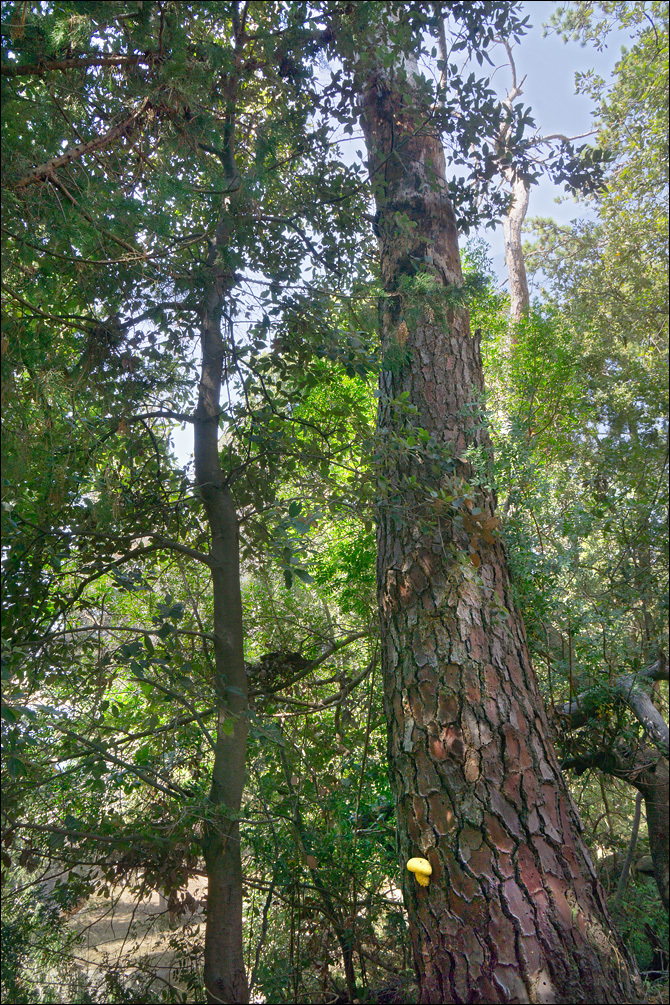
Slo.: jelovi privihanec - syn.: Boletus lignicola Kallenb., Gyrodon lignicola (Kallenb.) Heinem., Phlebopus lignicola (Kallenb.) Moser, Pulveroboletus lignicola (Kallenb.) Dick & Snell, Xerocomus lignicola (Kallenb.) Singer. - Habitat: mixed Mediterranean forest, at the edge of a large group of Pinus pinaster (cf.) trees, almost certainly planted around an old, abandoned villa (in a park); sea shore, south aspect, sandy bedrock; dry, sunny place; in shade; partly protected from direct rain by tree canopies; average precipitations ~ 900 mm/year, average temperature 12-14 deg C, elevation 8 m (25 feet), Mediterranean phytogeographical region. Substratum: large, dead Pinus pinaster (cf.) tree; growing about 80 cm above ground level. Place: Island Rab, north part, near ferryboat harbor to island Krk, Adriatic Sea, Kvarner bay, Croatia EC. Comments: Buchwaldoboletus lignicola is a beautiful fungus and a true rarity. It is protected and on Red lists in many countries, Slovenia included. In some of them it is considered close to extinction. Genus Buchwaldoboletus, which comprises today about 12 species worldwide, was established and separated from genus Boletus in 1969. Three names were relevant in Europe: Buchwaldoboletus hemichrysus (Berk. & M.A. Curtis) Pilt, Buchwaldoboletus sphaerocephalus (Barla) Watling & T.H. Li and Buchwaldoboletus lignicola (Kallenb.) Pilt. Taxonomical history of the genus is complex and at the time (in 1947) these three names (or at least two) were synonymous and put to genus Pulveroboletus. Even today several scholars consider B. hemichrysus and B. sphaerocephalus as synonyms. However, currently Index Fungorum recognizes all three mention names as current species names. B. hemichrysus is considered as an American species (reports from Europe refer to B. sphaerocephalus according to Ref.:11) while B. sphaerocephalus (people who consider B. sphaerocephalus = B. hemichrysus would use the latter name) and B. lignicola are European species. Description of characteristic traits of Buchwaldoboletus lignicola in literature is widely scattered. For example, in the literature given below the color of the hut is described as: beige, brown, brown-ochre, brown-reddish, golden-brown, light brown, ochraceous, ochre-creamy, ochre-yellow, orange yellow, orange-brown, reddish-brown, rusty, rusty-brown, some shade of brown, yellow-brown and yellow-ochre, while for the alternative B. sphaerocephalus/hemychrisus similar colors are given from yellow to brown with the average shifted toward yellow. Obviously, if one finds a single fruitbody, such information is of little help for determination. In addition, this find seems yellow through, which fits best to the description 'completely yellow fruitbody' given in Ref.: 2. Based on this B. sphaerocephalus would seem a better choice. However, Krieglsteiner (2000), Ref.5., p 287 in his key as well as Ortiz-Santana (2011), Ref.12., p 2 both state as an important discriminating trait of B. lignicola a thin gelatinous layer between tomentum and trama of the hut, which is not present in B. sphaerocephalus. This layer was clearly visible in this find. The layer was apparent even during preparation of the cutis for microscopy at low magnification of a dissecting microscope. Also hypha of this layer with no clamps corresponds well to the description in Breitenbach (1991), Ref.2. This led me to believe that the find is B. lignicola. Many other traits fit well to this choice. Yet, several do not. Color of the hut seems too yellow (young fruitbody?), the shape of the stipe is not equal as described for B. lignicola but club shaped, rooted and too thick, observed bluing fits only marginally to the description. Redding of the base of the stipe when cut is mentioned nowhere. Spore dimensions seem OK taking into account wide scatter of data from different sources. Description of the find. Growing solitary; hut 85 mm in diameter, trama 20 mm thick, pore layer up to 8 mm thick; tubes detersible (can be easily separated from trama); pores only slightly decurrent; stipe club shaped and slightly rooting, 8 cm long and up to 4 cm in diameter; fruitbody not bluing when handled, only pores do slightly (blue-green); when cut trama slowly bluing here and there to some extent, mostly in the base of the stipe and above pore layer, rooting part of the stipe changes to reddish; bluing disappears after about half on an hour and trama becomes again pale yellowish; after a day or two pore layer becomes dark brown with olive tint and the whole fruitbody turns darker, muddy yellow-orange-reddish; smell distinctive but not strong, pleasant, mushroomy; taste mild, indistinctive; KOH 5% reaction on pileus and trama distinctive but not violent, reddish-brown; on pored dark reddish-brown, almost black; SP abundant, brown, oac818. Spores smooth, dimensions: (6,4) 6,8 - 7,5 (8) x (3,7) 3,75 - 4,25 (4,3) microns; Q = (1,6) 1,7 - 1,9 (2); N = 30; Me = 7,1 x 4 microns; Qe = 1,8. Simple septa. Olympus CH20, NEA 100x/1.25, magnification 1.000 x, oil (spores); NEA 40x/0.65, magnification 400x (cuticle, hypha), NEA 10x/0.25, magnification 100x (cuticle, hypha), in water, about four days old material, not yet completely dry. AmScope MA500 digital camera. In Slovenia protected according to: Uredba o zavarovanih prostoiveih vrstah gliv, Uradni list RS, t. 58/2011 (Regulation of protected wild fungi, Official Gazette of Republic Slovenia, no. 58/2011), (2011). Also on our Red list. Herbarium: Mycotheca and lichen herbarium (LJU-Li) of Slovenian Forestry Institute, Vena pot 2, Ljubljana, Index Herbariorum LJF Ref.: (1) https://www.123pilze.de/DreamHC/Download/Nadelholzroehrling.htm (accessed on Sept. 10. 2017) (2) J. Breitenbach, F. Kraenzlin, Eds., Fungi of Switzerland, Vol.3. Verlag Mykologia (1991), p 76. (3) http://boletales.com/genera/buchwaldoboletus/b-lignicola/ (accessed on Sept. 7. 2017) (4) http://boletales.com/genera/buchwaldoboletus/b-sphaerocephalus/ (accessed on Sept. 7. 2017) (5) G.J. Krieglsteiner (Hrsg.), Die Grosspilze Baden-Wrttembergs, Band 2, Ulmer (2000), p 289 and 291. (6) S. Buczacki, Collins Fungi Guide, Collins (2012), p 408. (7) R. Phillips, Mushrooms, Macmillan (2006), p 283. (8) L. Hagar, Ottova Encyklopedia Hb, Ottova Nakladatelstvi, Praha (2015) (in Slovakian), p 573 and 574. (9) G. Kibby, British Boletes, Copyright Geoffrey Kibby (2011), p 21. (10) http://www.first-nature.com/fungi/buchwaldoboletus-lignicola.php (accessed on Sept. 7. 2017) (11) Blanco-Dios JB, Notes on the genus Buchwaldoboletus in Galicia and North of Portugal, Mycosphere 4 (5): 945950 (2013); available at: http://www.mycosphere.org/pdf/MC4_5_No7.pdf (12) B. Ortiz-Santana, A Preliminary Survey of the Genus Buchwaldoboletus (Boletales: Boletaceae), Bull. Buffalo Soc, of Nat. Sci., Vol. 40. (2011), p 1.
-
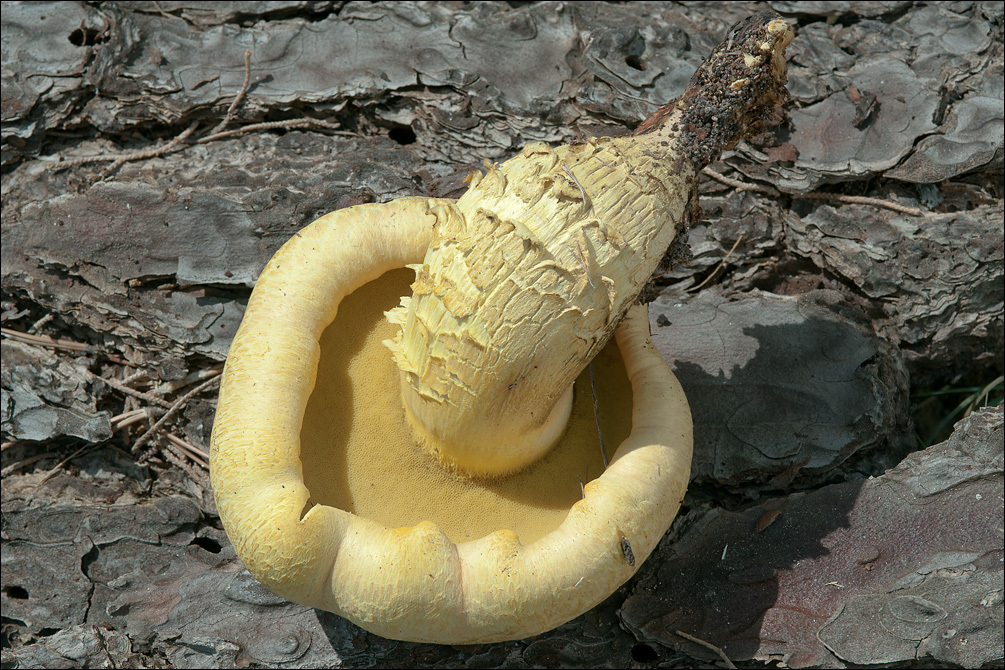
Slo.: jelovi privihanec - syn.: Boletus lignicola Kallenb., Gyrodon lignicola (Kallenb.) Heinem., Phlebopus lignicola (Kallenb.) Moser, Pulveroboletus lignicola (Kallenb.) Dick & Snell, Xerocomus lignicola (Kallenb.) Singer. - Habitat: mixed Mediterranean forest, at the edge of a large group of Pinus pinaster (cf.) trees, almost certainly planted around an old, abandoned villa (in a park); sea shore, south aspect, sandy bedrock; dry, sunny place; in shade; partly protected from direct rain by tree canopies; average precipitations ~ 900 mm/year, average temperature 12-14 deg C, elevation 8 m (25 feet), Mediterranean phytogeographical region. Substratum: large, dead Pinus pinaster (cf.) tree; growing about 80 cm above ground level. Place: Island Rab, north part, near ferryboat harbor to island Krk, Adriatic Sea, Kvarner bay, Croatia EC. Comments: Buchwaldoboletus lignicola is a beautiful fungus and a true rarity. It is protected and on Red lists in many countries, Slovenia included. In some of them it is considered close to extinction. Genus Buchwaldoboletus, which comprises today about 12 species worldwide, was established and separated from genus Boletus in 1969. Three names were relevant in Europe: Buchwaldoboletus hemichrysus (Berk. & M.A. Curtis) Pilt, Buchwaldoboletus sphaerocephalus (Barla) Watling & T.H. Li and Buchwaldoboletus lignicola (Kallenb.) Pilt. Taxonomical history of the genus is complex and at the time (in 1947) these three names (or at least two) were synonymous and put to genus Pulveroboletus. Even today several scholars consider B. hemichrysus and B. sphaerocephalus as synonyms. However, currently Index Fungorum recognizes all three mention names as current species names. B. hemichrysus is considered as an American species (reports from Europe refer to B. sphaerocephalus according to Ref.:11) while B. sphaerocephalus (people who consider B. sphaerocephalus = B. hemichrysus would use the latter name) and B. lignicola are European species. Description of characteristic traits of Buchwaldoboletus lignicola in literature is widely scattered. For example, in the literature given below the color of the hut is described as: beige, brown, brown-ochre, brown-reddish, golden-brown, light brown, ochraceous, ochre-creamy, ochre-yellow, orange yellow, orange-brown, reddish-brown, rusty, rusty-brown, some shade of brown, yellow-brown and yellow-ochre, while for the alternative B. sphaerocephalus/hemychrisus similar colors are given from yellow to brown with the average shifted toward yellow. Obviously, if one finds a single fruitbody, such information is of little help for determination. In addition, this find seems yellow through, which fits best to the description 'completely yellow fruitbody' given in Ref.: 2. Based on this B. sphaerocephalus would seem a better choice. However, Krieglsteiner (2000), Ref.5., p 287 in his key as well as Ortiz-Santana (2011), Ref.12., p 2 both state as an important discriminating trait of B. lignicola a thin gelatinous layer between tomentum and trama of the hut, which is not present in B. sphaerocephalus. This layer was clearly visible in this find. The layer was apparent even during preparation of the cutis for microscopy at low magnification of a dissecting microscope. Also hypha of this layer with no clamps corresponds well to the description in Breitenbach (1991), Ref.2. This led me to believe that the find is B. lignicola. Many other traits fit well to this choice. Yet, several do not. Color of the hut seems too yellow (young fruitbody?), the shape of the stipe is not equal as described for B. lignicola but club shaped, rooted and too thick, observed bluing fits only marginally to the description. Redding of the base of the stipe when cut is mentioned nowhere. Spore dimensions seem OK taking into account wide scatter of data from different sources. Description of the find. Growing solitary; hut 85 mm in diameter, trama 20 mm thick, pore layer up to 8 mm thick; tubes detersible (can be easily separated from trama); pores only slightly decurrent; stipe club shaped and slightly rooting, 8 cm long and up to 4 cm in diameter; fruitbody not bluing when handled, only pores do slightly (blue-green); when cut trama slowly bluing here and there to some extent, mostly in the base of the stipe and above pore layer, rooting part of the stipe changes to reddish; bluing disappears after about half on an hour and trama becomes again pale yellowish; after a day or two pore layer becomes dark brown with olive tint and the whole fruitbody turns darker, muddy yellow-orange-reddish; smell distinctive but not strong, pleasant, mushroomy; taste mild, indistinctive; KOH 5% reaction on pileus and trama distinctive but not violent, reddish-brown; on pored dark reddish-brown, almost black; SP abundant, brown, oac818. Spores smooth, dimensions: (6,4) 6,8 - 7,5 (8) x (3,7) 3,75 - 4,25 (4,3) microns; Q = (1,6) 1,7 - 1,9 (2); N = 30; Me = 7,1 x 4 microns; Qe = 1,8. Simple septa. Olympus CH20, NEA 100x/1.25, magnification 1.000 x, oil (spores); NEA 40x/0.65, magnification 400x (cuticle, hypha), NEA 10x/0.25, magnification 100x (cuticle, hypha), in water, about four days old material, not yet completely dry. AmScope MA500 digital camera. In Slovenia protected according to: Uredba o zavarovanih prostoiveih vrstah gliv, Uradni list RS, t. 58/2011 (Regulation of protected wild fungi, Official Gazette of Republic Slovenia, no. 58/2011), (2011). Also on our Red list. Herbarium: Mycotheca and lichen herbarium (LJU-Li) of Slovenian Forestry Institute, Vena pot 2, Ljubljana, Index Herbariorum LJF Ref.: (1) https://www.123pilze.de/DreamHC/Download/Nadelholzroehrling.htm (accessed on Sept. 10. 2017) (2) J. Breitenbach, F. Kraenzlin, Eds., Fungi of Switzerland, Vol.3. Verlag Mykologia (1991), p 76. (3) http://boletales.com/genera/buchwaldoboletus/b-lignicola/ (accessed on Sept. 7. 2017) (4) http://boletales.com/genera/buchwaldoboletus/b-sphaerocephalus/ (accessed on Sept. 7. 2017) (5) G.J. Krieglsteiner (Hrsg.), Die Grosspilze Baden-Wrttembergs, Band 2, Ulmer (2000), p 289 and 291. (6) S. Buczacki, Collins Fungi Guide, Collins (2012), p 408. (7) R. Phillips, Mushrooms, Macmillan (2006), p 283. (8) L. Hagar, Ottova Encyklopedia Hb, Ottova Nakladatelstvi, Praha (2015) (in Slovakian), p 573 and 574. (9) G. Kibby, British Boletes, Copyright Geoffrey Kibby (2011), p 21. (10) http://www.first-nature.com/fungi/buchwaldoboletus-lignicola.php (accessed on Sept. 7. 2017) (11) Blanco-Dios JB, Notes on the genus Buchwaldoboletus in Galicia and North of Portugal, Mycosphere 4 (5): 945950 (2013); available at: http://www.mycosphere.org/pdf/MC4_5_No7.pdf (12) B. Ortiz-Santana, A Preliminary Survey of the Genus Buchwaldoboletus (Boletales: Boletaceae), Bull. Buffalo Soc, of Nat. Sci., Vol. 40. (2011), p 1.
-
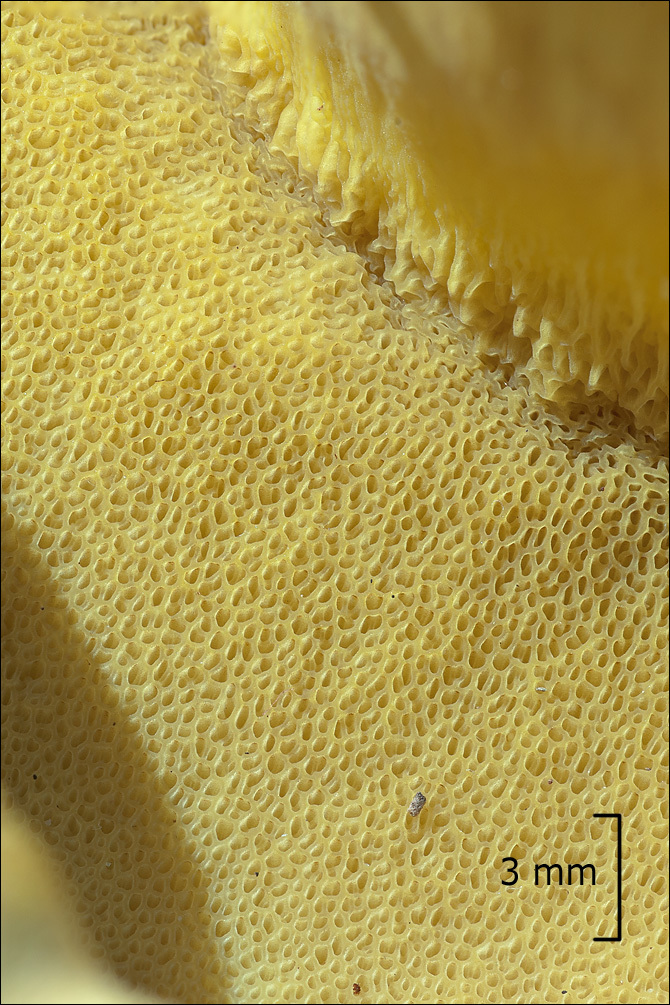
Slo.: jelovi privihanec - syn.: Boletus lignicola Kallenb., Gyrodon lignicola (Kallenb.) Heinem., Phlebopus lignicola (Kallenb.) Moser, Pulveroboletus lignicola (Kallenb.) Dick & Snell, Xerocomus lignicola (Kallenb.) Singer. - Habitat: mixed Mediterranean forest, at the edge of a large group of Pinus pinaster (cf.) trees, almost certainly planted around an old, abandoned villa (in a park); sea shore, south aspect, sandy bedrock; dry, sunny place; in shade; partly protected from direct rain by tree canopies; average precipitations ~ 900 mm/year, average temperature 12-14 deg C, elevation 8 m (25 feet), Mediterranean phytogeographical region. Substratum: large, dead Pinus pinaster (cf.) tree; growing about 80 cm above ground level. Place: Island Rab, north part, near ferryboat harbor to island Krk, Adriatic Sea, Kvarner bay, Croatia EC. Comments: Buchwaldoboletus lignicola is a beautiful fungus and a true rarity. It is protected and on Red lists in many countries, Slovenia included. In some of them it is considered close to extinction. Genus Buchwaldoboletus, which comprises today about 12 species worldwide, was established and separated from genus Boletus in 1969. Three names were relevant in Europe: Buchwaldoboletus hemichrysus (Berk. & M.A. Curtis) Pilt, Buchwaldoboletus sphaerocephalus (Barla) Watling & T.H. Li and Buchwaldoboletus lignicola (Kallenb.) Pilt. Taxonomical history of the genus is complex and at the time (in 1947) these three names (or at least two) were synonymous and put to genus Pulveroboletus. Even today several scholars consider B. hemichrysus and B. sphaerocephalus as synonyms. However, currently Index Fungorum recognizes all three mention names as current species names. B. hemichrysus is considered as an American species (reports from Europe refer to B. sphaerocephalus according to Ref.:11) while B. sphaerocephalus (people who consider B. sphaerocephalus = B. hemichrysus would use the latter name) and B. lignicola are European species. Description of characteristic traits of Buchwaldoboletus lignicola in literature is widely scattered. For example, in the literature given below the color of the hut is described as: beige, brown, brown-ochre, brown-reddish, golden-brown, light brown, ochraceous, ochre-creamy, ochre-yellow, orange yellow, orange-brown, reddish-brown, rusty, rusty-brown, some shade of brown, yellow-brown and yellow-ochre, while for the alternative B. sphaerocephalus/hemychrisus similar colors are given from yellow to brown with the average shifted toward yellow. Obviously, if one finds a single fruitbody, such information is of little help for determination. In addition, this find seems yellow through, which fits best to the description 'completely yellow fruitbody' given in Ref.: 2. Based on this B. sphaerocephalus would seem a better choice. However, Krieglsteiner (2000), Ref.5., p 287 in his key as well as Ortiz-Santana (2011), Ref.12., p 2 both state as an important discriminating trait of B. lignicola a thin gelatinous layer between tomentum and trama of the hut, which is not present in B. sphaerocephalus. This layer was clearly visible in this find. The layer was apparent even during preparation of the cutis for microscopy at low magnification of a dissecting microscope. Also hypha of this layer with no clamps corresponds well to the description in Breitenbach (1991), Ref.2. This led me to believe that the find is B. lignicola. Many other traits fit well to this choice. Yet, several do not. Color of the hut seems too yellow (young fruitbody?), the shape of the stipe is not equal as described for B. lignicola but club shaped, rooted and too thick, observed bluing fits only marginally to the description. Redding of the base of the stipe when cut is mentioned nowhere. Spore dimensions seem OK taking into account wide scatter of data from different sources. Description of the find. Growing solitary; hut 85 mm in diameter, trama 20 mm thick, pore layer up to 8 mm thick; tubes detersible (can be easily separated from trama); pores only slightly decurrent; stipe club shaped and slightly rooting, 8 cm long and up to 4 cm in diameter; fruitbody not bluing when handled, only pores do slightly (blue-green); when cut trama slowly bluing here and there to some extent, mostly in the base of the stipe and above pore layer, rooting part of the stipe changes to reddish; bluing disappears after about half on an hour and trama becomes again pale yellowish; after a day or two pore layer becomes dark brown with olive tint and the whole fruitbody turns darker, muddy yellow-orange-reddish; smell distinctive but not strong, pleasant, mushroomy; taste mild, indistinctive; KOH 5% reaction on pileus and trama distinctive but not violent, reddish-brown; on pored dark reddish-brown, almost black; SP abundant, brown, oac818. Spores smooth, dimensions: (6,4) 6,8 - 7,5 (8) x (3,7) 3,75 - 4,25 (4,3) microns; Q = (1,6) 1,7 - 1,9 (2); N = 30; Me = 7,1 x 4 microns; Qe = 1,8. Simple septa. Olympus CH20, NEA 100x/1.25, magnification 1.000 x, oil (spores); NEA 40x/0.65, magnification 400x (cuticle, hypha), NEA 10x/0.25, magnification 100x (cuticle, hypha), in water, about four days old material, not yet completely dry. AmScope MA500 digital camera. In Slovenia protected according to: Uredba o zavarovanih prostoiveih vrstah gliv, Uradni list RS, t. 58/2011 (Regulation of protected wild fungi, Official Gazette of Republic Slovenia, no. 58/2011), (2011). Also on our Red list. Herbarium: Mycotheca and lichen herbarium (LJU-Li) of Slovenian Forestry Institute, Vena pot 2, Ljubljana, Index Herbariorum LJF Ref.: (1) https://www.123pilze.de/DreamHC/Download/Nadelholzroehrling.htm (accessed on Sept. 10. 2017) (2) J. Breitenbach, F. Kraenzlin, Eds., Fungi of Switzerland, Vol.3. Verlag Mykologia (1991), p 76. (3) http://boletales.com/genera/buchwaldoboletus/b-lignicola/ (accessed on Sept. 7. 2017) (4) http://boletales.com/genera/buchwaldoboletus/b-sphaerocephalus/ (accessed on Sept. 7. 2017) (5) G.J. Krieglsteiner (Hrsg.), Die Grosspilze Baden-Wrttembergs, Band 2, Ulmer (2000), p 289 and 291. (6) S. Buczacki, Collins Fungi Guide, Collins (2012), p 408. (7) R. Phillips, Mushrooms, Macmillan (2006), p 283. (8) L. Hagar, Ottova Encyklopedia Hb, Ottova Nakladatelstvi, Praha (2015) (in Slovakian), p 573 and 574. (9) G. Kibby, British Boletes, Copyright Geoffrey Kibby (2011), p 21. (10) http://www.first-nature.com/fungi/buchwaldoboletus-lignicola.php (accessed on Sept. 7. 2017) (11) Blanco-Dios JB, Notes on the genus Buchwaldoboletus in Galicia and North of Portugal, Mycosphere 4 (5): 945950 (2013); available at: http://www.mycosphere.org/pdf/MC4_5_No7.pdf (12) B. Ortiz-Santana, A Preliminary Survey of the Genus Buchwaldoboletus (Boletales: Boletaceae), Bull. Buffalo Soc, of Nat. Sci., Vol. 40. (2011), p 1.
-
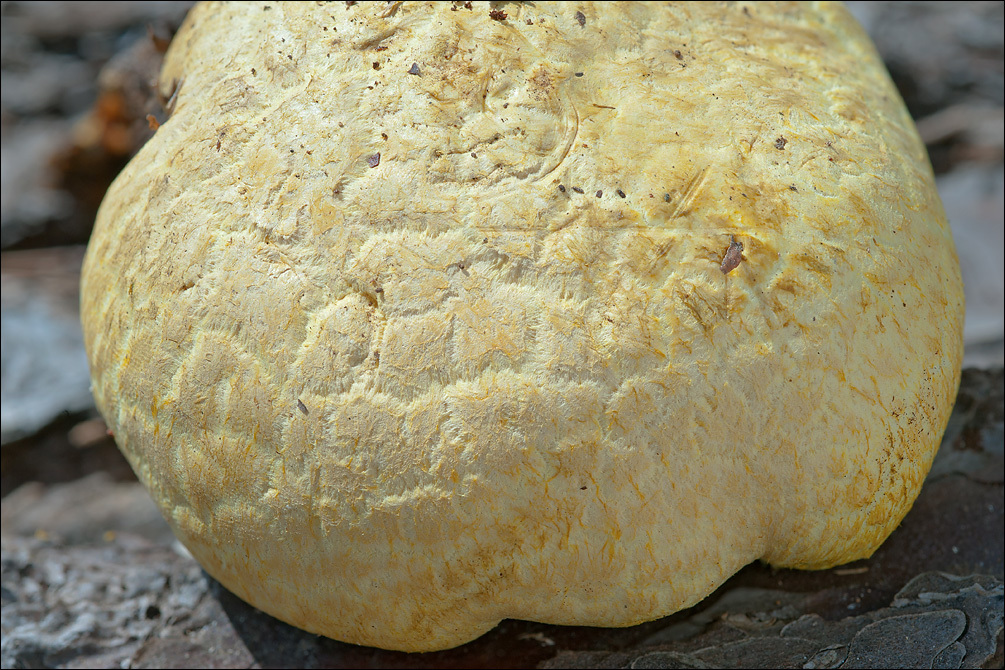
Slo.: jelovi privihanec - syn.: Boletus lignicola Kallenb., Gyrodon lignicola (Kallenb.) Heinem., Phlebopus lignicola (Kallenb.) Moser, Pulveroboletus lignicola (Kallenb.) Dick & Snell, Xerocomus lignicola (Kallenb.) Singer. - Habitat: mixed Mediterranean forest, at the edge of a large group of Pinus pinaster (cf.) trees, almost certainly planted around an old, abandoned villa (in a park); sea shore, south aspect, sandy bedrock; dry, sunny place; in shade; partly protected from direct rain by tree canopies; average precipitations ~ 900 mm/year, average temperature 12-14 deg C, elevation 8 m (25 feet), Mediterranean phytogeographical region. Substratum: large, dead Pinus pinaster (cf.) tree; growing about 80 cm above ground level. Place: Island Rab, north part, near ferryboat harbor to island Krk, Adriatic Sea, Kvarner bay, Croatia EC. Comments: Buchwaldoboletus lignicola is a beautiful fungus and a true rarity. It is protected and on Red lists in many countries, Slovenia included. In some of them it is considered close to extinction. Genus Buchwaldoboletus, which comprises today about 12 species worldwide, was established and separated from genus Boletus in 1969. Three names were relevant in Europe: Buchwaldoboletus hemichrysus (Berk. & M.A. Curtis) Pilt, Buchwaldoboletus sphaerocephalus (Barla) Watling & T.H. Li and Buchwaldoboletus lignicola (Kallenb.) Pilt. Taxonomical history of the genus is complex and at the time (in 1947) these three names (or at least two) were synonymous and put to genus Pulveroboletus. Even today several scholars consider B. hemichrysus and B. sphaerocephalus as synonyms. However, currently Index Fungorum recognizes all three mention names as current species names. B. hemichrysus is considered as an American species (reports from Europe refer to B. sphaerocephalus according to Ref.:11) while B. sphaerocephalus (people who consider B. sphaerocephalus = B. hemichrysus would use the latter name) and B. lignicola are European species. Description of characteristic traits of Buchwaldoboletus lignicola in literature is widely scattered. For example, in the literature given below the color of the hut is described as: beige, brown, brown-ochre, brown-reddish, golden-brown, light brown, ochraceous, ochre-creamy, ochre-yellow, orange yellow, orange-brown, reddish-brown, rusty, rusty-brown, some shade of brown, yellow-brown and yellow-ochre, while for the alternative B. sphaerocephalus/hemychrisus similar colors are given from yellow to brown with the average shifted toward yellow. Obviously, if one finds a single fruitbody, such information is of little help for determination. In addition, this find seems yellow through, which fits best to the description 'completely yellow fruitbody' given in Ref.: 2. Based on this B. sphaerocephalus would seem a better choice. However, Krieglsteiner (2000), Ref.5., p 287 in his key as well as Ortiz-Santana (2011), Ref.12., p 2 both state as an important discriminating trait of B. lignicola a thin gelatinous layer between tomentum and trama of the hut, which is not present in B. sphaerocephalus. This layer was clearly visible in this find. The layer was apparent even during preparation of the cutis for microscopy at low magnification of a dissecting microscope. Also hypha of this layer with no clamps corresponds well to the description in Breitenbach (1991), Ref.2. This led me to believe that the find is B. lignicola. Many other traits fit well to this choice. Yet, several do not. Color of the hut seems too yellow (young fruitbody?), the shape of the stipe is not equal as described for B. lignicola but club shaped, rooted and too thick, observed bluing fits only marginally to the description. Redding of the base of the stipe when cut is mentioned nowhere. Spore dimensions seem OK taking into account wide scatter of data from different sources. Description of the find. Growing solitary; hut 85 mm in diameter, trama 20 mm thick, pore layer up to 8 mm thick; tubes detersible (can be easily separated from trama); pores only slightly decurrent; stipe club shaped and slightly rooting, 8 cm long and up to 4 cm in diameter; fruitbody not bluing when handled, only pores do slightly (blue-green); when cut trama slowly bluing here and there to some extent, mostly in the base of the stipe and above pore layer, rooting part of the stipe changes to reddish; bluing disappears after about half on an hour and trama becomes again pale yellowish; after a day or two pore layer becomes dark brown with olive tint and the whole fruitbody turns darker, muddy yellow-orange-reddish; smell distinctive but not strong, pleasant, mushroomy; taste mild, indistinctive; KOH 5% reaction on pileus and trama distinctive but not violent, reddish-brown; on pored dark reddish-brown, almost black; SP abundant, brown, oac818. Spores smooth, dimensions: (6,4) 6,8 - 7,5 (8) x (3,7) 3,75 - 4,25 (4,3) microns; Q = (1,6) 1,7 - 1,9 (2); N = 30; Me = 7,1 x 4 microns; Qe = 1,8. Simple septa. Olympus CH20, NEA 100x/1.25, magnification 1.000 x, oil (spores); NEA 40x/0.65, magnification 400x (cuticle, hypha), NEA 10x/0.25, magnification 100x (cuticle, hypha), in water, about four days old material, not yet completely dry. AmScope MA500 digital camera. In Slovenia protected according to: Uredba o zavarovanih prostoiveih vrstah gliv, Uradni list RS, t. 58/2011 (Regulation of protected wild fungi, Official Gazette of Republic Slovenia, no. 58/2011), (2011). Also on our Red list. Herbarium: Mycotheca and lichen herbarium (LJU-Li) of Slovenian Forestry Institute, Vena pot 2, Ljubljana, Index Herbariorum LJF Ref.: (1) https://www.123pilze.de/DreamHC/Download/Nadelholzroehrling.htm (accessed on Sept. 10. 2017) (2) J. Breitenbach, F. Kraenzlin, Eds., Fungi of Switzerland, Vol.3. Verlag Mykologia (1991), p 76. (3) http://boletales.com/genera/buchwaldoboletus/b-lignicola/ (accessed on Sept. 7. 2017) (4) http://boletales.com/genera/buchwaldoboletus/b-sphaerocephalus/ (accessed on Sept. 7. 2017) (5) G.J. Krieglsteiner (Hrsg.), Die Grosspilze Baden-Wrttembergs, Band 2, Ulmer (2000), p 289 and 291. (6) S. Buczacki, Collins Fungi Guide, Collins (2012), p 408. (7) R. Phillips, Mushrooms, Macmillan (2006), p 283. (8) L. Hagar, Ottova Encyklopedia Hb, Ottova Nakladatelstvi, Praha (2015) (in Slovakian), p 573 and 574. (9) G. Kibby, British Boletes, Copyright Geoffrey Kibby (2011), p 21. (10) http://www.first-nature.com/fungi/buchwaldoboletus-lignicola.php (accessed on Sept. 7. 2017) (11) Blanco-Dios JB, Notes on the genus Buchwaldoboletus in Galicia and North of Portugal, Mycosphere 4 (5): 945950 (2013); available at: http://www.mycosphere.org/pdf/MC4_5_No7.pdf (12) B. Ortiz-Santana, A Preliminary Survey of the Genus Buchwaldoboletus (Boletales: Boletaceae), Bull. Buffalo Soc, of Nat. Sci., Vol. 40. (2011), p 1.



